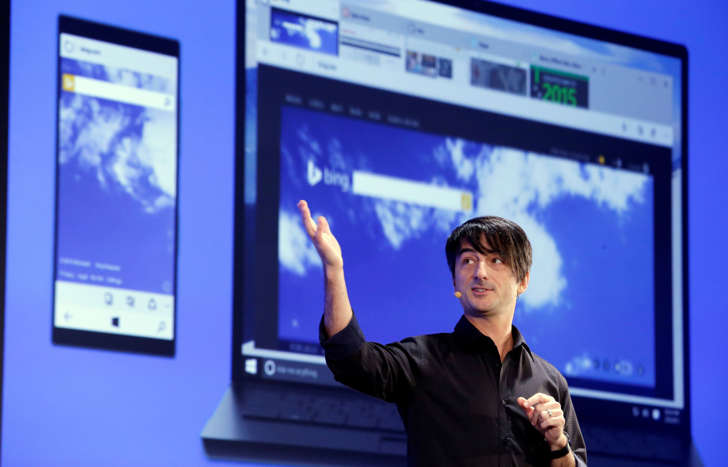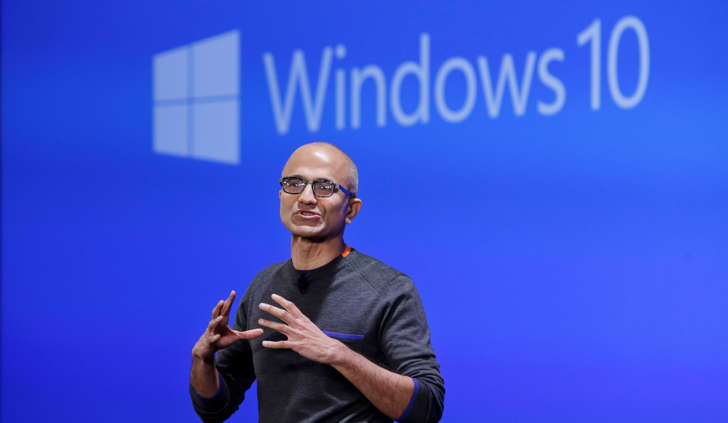 © Elaine Thompson/AP Microsoft’s Joe Belfiore, corporate vice president of Operating Systems Group, speaks at an event demonstrating new features of its flagship operating system Windows at the company’s headquarters Wednesday, …
© Elaine Thompson/AP Microsoft’s Joe Belfiore, corporate vice president of Operating Systems Group, speaks at an event demonstrating new features of its flagship operating system Windows at the company’s headquarters Wednesday, …
Microsoft Corp will give away its upcoming Windows 10 operating system as a free upgrade to users of the most recent versions of Windows and Windows Phone, as the world’s largest software company tries to hold onto customers in the new mobile era that has largely bypassed it.
The announcement by Terry Myerson, who runs Microsoft’s operating systems group, is a marked change for Microsoft, which has charged for new versions of Windows, one of its main profit drivers.
The new ‘free’ strategy is aimed at establishing Windows on as many devices as possible, and then trying to make up for lost revenue by selling valuable services such as Office over the internet, or cloud.
“It’s a necessary evil as CEO Satya Nadella and Microsoft have recognized the ‘golden goose’ and major revenue opportunities will happen after the upgrades have taken place” said Daniel Ives, an analyst at FBR Capital Markets.
“Microsoft needs to lay seeds for its cloud-centric strategy and Windows 10 is the epicenter of that strategy. It’s all about making it attractive for the ecosystem to upgrade onto this next-generation platform.”
Windows 10, expected on the market this autumn, will be available for one year as a free upgrade to users of Windows 7, Windows 8.1 and Windows Phone 8.1, Myerson said.
The move is a recognition that, in the last decade, Windows, featured on roughly 15 percent of computing devices including phones and tablets, has become largely irrelevant for many consumers. Microsoft hopes that by making the software free, it will attract the more than 1 billion personal computer users of Windows to run it on other devices.
 © Elaine Thompson/AP Microsoft CEO Satya Nadella speaks at an event demonstrating the new features of Windows 10 at the company’s headquarters Wednesday, Jan. 21, 2015, in Redmond, Wash. Executives demonstrated how they said the new… The new approach, which Myerson called “Windows as a service” takes a similar approach to Apple Inc and Google Inc, which regularly update their software systems free for customers.
© Elaine Thompson/AP Microsoft CEO Satya Nadella speaks at an event demonstrating the new features of Windows 10 at the company’s headquarters Wednesday, Jan. 21, 2015, in Redmond, Wash. Executives demonstrated how they said the new… The new approach, which Myerson called “Windows as a service” takes a similar approach to Apple Inc and Google Inc, which regularly update their software systems free for customers.
The move was “inevitable,” according to Forrester analyst Frank Gillett.
“The way to motivate consumers is to make upgrades transparent and painless – meaning free and low-to-no effort,” he said. “Microsoft had to match the expectation set by the mobile and Web leaders.”
At an event to show off some upcoming features in Windows 10, Microsoft also unveiled its Cortana voice-activated search function for the PC desktop, which has only been available on mobile devices.
Executives also showed off an Xbox app for games on Windows 10 and a new version of its browser code named ‘Spartan’, which lets users make notes on Web pages and share them.
Microsoft announced its new Windows 10 operating system in September, billing it as a move to unify all kinds of device users. It skipped Windows 9 altogether, to put some distance between the new system and Windows 8, which confused many users by ditching the start button menu and using a new layout.
